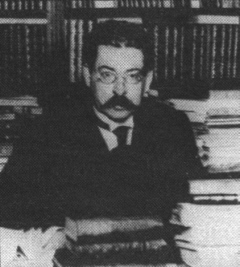José Enrique Rodó facts for kids
Quick facts for kids
José Enrique Rodó
|
|
|---|---|
 |
|
| Born | José Enrique Camilo Rodó Piñeyro July 15, 1871 Montevideo, Uruguay |
| Died | May 1, 1917 (aged 45) Palermo, Italy |
| Occupation | essayist |
| Nationality | Uruguayan |
José Enrique Camilo Rodó Piñeyro (born July 15, 1871 – died May 1, 1917) was an important writer from Uruguay. He was known for his essays, which are short pieces of writing that explore a topic. Rodó wrote to many famous thinkers of his time, including Rubén Darío, a very influential poet from Latin America.
Rodó is best known for his famous essay called Ariel, which he wrote in 1900. In this essay, he used characters from William Shakespeare's play The Tempest. Ariel represents the good and positive parts of human nature. Caliban, on the other hand, stands for the negative parts. They discuss the future of society. Rodó wanted this essay to be like a guide for young people in Latin America. He encouraged them to value classic traditions and ideas. He worried that people might get stuck doing the same work over and over, without time to grow their minds and spirits. In Uruguay, many young people also know him because of Parque Rodó, a park in Montevideo named after him.
For over a hundred years, Ariel has been a very important essay in Latin American culture. It talks about classic values and criticizes ideas like "utilitarianism" and "nordomanía," which we will explain below.
Contents
What is Ariel About?
Ariel is part of a literary movement called modernismo. This style of writing is known for being elegant, artistic, and full of references to different cultures. Even though Ariel is an essay, its ideas are shared through the voice of a character named Prospero.
Characters from The Tempest
Prospero is the teacher in the essay, and Ariel is his student. These names come from Shakespeare's play The Tempest. Using these names shows how modernismo writers liked to include ideas from all over the world. In Ariel, Prospero's lessons include famous European writers like Goethe and Schiller. He also talks about places like Ancient Greece. Rodó believed that the beauty of ancient Greece was an ideal to follow.
Ariel vs. Caliban
Rodó uses Ariel as a symbol for beauty, spirit, and all that is good. The opposite of Ariel is Caliban, who represents a focus on usefulness above all else. Rodó saw two main reasons why this "usefulness-first" idea was becoming popular: positivismo (a philosophy focused on scientific facts) and nordomanía. The essay is built on contrasting Ariel and Caliban, showing two very different ways of thinking.
Valuing Classical Culture
In Ariel, Rodó looked at the challenges Latin America faced in the late 1800s. He believed that focusing too much on usefulness and material things could make people's minds less rich. This could also harm their spirit. To help Latin America's spirit grow, Rodó suggested following the beautiful ideals of ancient Greek and Roman cultures. He thought these cultures valued beauty and the importance of thinking and learning. For Rodó, art was a way to learn and enrich the spirit, moving away from just being useful.
What is Utilitarianism?
Rodó strongly criticized a way of thinking called utilitarianism. This philosophy suggests that the best actions are those that bring the most happiness to the most people. Rodó said that "Ariel" means choosing an ideal way of life over the limits of utilitarianism.
He argued that utilitarianism makes people specialize in very specific jobs. This can lead to an incomplete education. Someone might be brilliant in one area but not know much about anything else. Rodó believed that too much specialization could stop societies from truly growing and becoming mature. He felt it could lead to "mediocrity," meaning average quality.
Rodó also mentioned that democracy, as it was practiced then, could sometimes lead to mediocrity. He explained that if power is given to the masses (the general public), and they are not well-educated, it might lead to poor decisions. However, Rodó was not against democracy itself. He suggested ways to make it stronger. For example, he believed that the most capable people should help educate everyone else. This would raise the overall level of society, rather than letting it fall.
Understanding "Nordomanía"
Rodó warned against "nordomanía." This term describes a strong attraction to North America, especially its focus on material wealth. He saw this as a powerful trend in North America. However, Rodó also believed that writers could find their own unique style by looking at American writers like Walt Whitman. Another way was to be inspired by nature.
Rodó's ideas came from watching history unfold. The United States was growing in power in the Western Hemisphere, especially in Latin America, in the early 1900s. Rodó emphasized how important it was for each country to have its own strong regional identity. He believed this identity should be deeply rooted in each nation's history.
However, creating and keeping a regional identity can be hard when other cultures and economies have a strong influence. Rodó saw many examples of this, like the Spanish–American War of 1898. He argued that even if outside influences seem helpful, they might destroy the basic principles of a country or region. Because of this, Rodó felt it was the job of young people in Spanish America to help form and protect their regional and cultural identity as best they could.
Images for kids
-
Monument to José Enrique Rodó in Parque Rodó
See also
 In Spanish: José Enrique Rodó para niños
In Spanish: José Enrique Rodó para niños
More to Read
- Antuña, José. "Rodó's Ariel". Américas 13.3 (March 1961): 32–34.
- Earle, Peter G. "José Enrique Rodó". Latin American Writers. Vol. II. Ed. Solé/Abreu. NY: Charles Scribner's Sons, 1989: II: 447–455.
- San Román, Gustavo. A Companion to José Enrique Rodó. Woodbridge: Tamesis, 2018.


